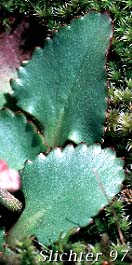 Leaves of the Alberta saxifrage
at right.
Leaves of the Alberta saxifrage
at right.
Western saxifrage (Saxifraga occidentalis) is a species that once had numerous varieties included in it. Recently, many of these varieties have been split into their own species. According to the USDA Plants website, western saxifrage was recently renamed Alberta saxifrage and includes varieties allenii which is found along the eastern slope of the Cascades into the eastern Columbia River Gorge and wallowensis which is more northerly and easterly . I've retained the name western saxifrage here as that is what many of us who view flowers in the gorge are used to.
Western saxifrage is a perennial with single, simple stems arising from 5-20 cm high from a cluster of several basal leaves. The stems arise from a short rhizome, are short-hairy, and are often reddish-glandular. The thick leaf blades are elliptical or egg-shaped, or occasionally roughly triangular in outline with coarsely toothed margins (15-30 teeth). The blade tapers gradually to a broad petiole, or occasionally rather abruptly to the petiole, giving the leaf in that case a triangular outline. The blades are up to 6 cm long and to 3 cm wide and may be rusty-hairy beneath. A way to remember how to identify Saxifraga occidentalis in the eastern Columbia River Gorge is that is leaf margins are noticeably dentate as in the photo at right.
The inflorescence is a narrow to widely branched cyme, the cyme being pyramidal in outline with the branches mostly ascending. The result may be tightly clustered to widely spaced flowers. The flowers are about 5-6 mm wide, usually white with 10 yellow spots near the center. There are 5 petals, and each is egg-shaped. The sepals are blunt-tipped and reflexed out from the petals. The filaments will generally appear club-shaped.
Rustyhair Saxifrage: Saxifraga rufidula (formerly Saxifraga occidentalis var. rufidula) - Very similar to Alberta saxifrage with its dentate leaves, but perhaps more westerly located in the Columbia River Gorge. The inflorescence is a broad, flat-topped cyme with the bracts and calyces often covered with reddish, wooly or curly hairs. The filaments are only slightly or not club-shaped.
Western saxifrage may be found on seasonally moist (spring) slopes, cliffs, and banks from sea level to alpine habitats.
Western saxifrage may be found from British Columbia south on both sides of the Cascades to northwest Oregon, and east across Oregon and Washington to Idaho, Montana, northwestern Wyoming, and as far south as Elko County, Nevada. In Canada, it may be found as far east as Alberta.
In the Columbia River Gorge, it (variety rufidula) may be found between the elevations of 100'-4500' from near Crown Pt. in the west to as far east as The Dalles, OR.